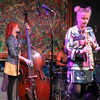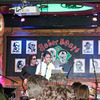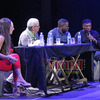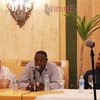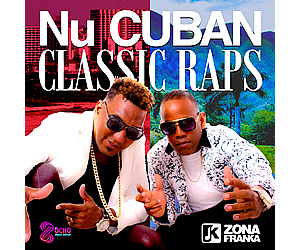Indice - Table of contents
New Stuff[hide]
Reportes: From The St... : Jazz Plaza ...
Fotos: Tom Ehrlich : Irakere 50th Annivers...
Fotos: Tom Ehrlich : Irakere
Resenas: Joey Altruda Presents: El Gran ...
Reportes: From The St... : Cubadisco 2...
Timbapedia: 09. Interviews -... : Carlos del Pino ...
Fotos: Tom Ehrlich : 2023 Monterey Jazz Fe...
Fotos: Tom Ehrlich : 2023 Monterey Jazz Fe...
Fotos: Tom Ehrlich : 2023 Monterey Jazz Fe...
Fotos: Tom Ehrlich : 2023 Monterey Jazz Fe...
Grupos: Tirso Duarte
Grupos: Tirso Duarte : Discography
Grupos: Charanga Habaner... : 8. El bla bla bla
Grupos: Pupy y los que S... : Tirso Duarte
Photos of the Day [hide]
SpanishEnglishEntrevista con Enrique Lazaga - Page 3
There are some people in the United States that are trying to convince EGREM to remaster the RO discs.
When I was there [New York], every time they announced my name…Have you been to New York?... I went to play a few concerts at the Lincoln Center and when they announced me, ‘Here is the director of Ritmo Oriental,’ the people would say, ‘but when is your group going to come here to play, when are you going to come.’
People don’t realize what the RO really was, but it was one of the most popular orchestras here…and I’m not saying that because it was my group or anything, but what we did, nobody did, not Van Van or Estrellas Cubanas, not close, you know. When someone would say, ‘hey there’s the RO, everything would stop, the world would end, because but we did was terrible [Translator’s Note: meaning incredible]. Wait a minute; I’m going to show you something [going into his bedroom to come back with a stack of large black and white photos]. Look at this a RO dance, were all dressed up in suits, look at all the people. Look…look at the RO in suits. You see, I’m playing the tumbadora and that was the guiro player. Wait, what I wanted to show you was this…look at how we dressed. Look, this is what I wanted to show you. Do you know who that is? David Calzado. You know who this is? Toni Cala. You know what this is? This is the RO doing choreograph. This is what the Charanga Habanera does today. Look at me, it gives me goose bumps. That came from us. That is what we did. That is what we did when Oscar de León came here and there was no one who could stand up to him and his challenge. And we were called to go and play, and we went and we put him between a rock and the people, hahaha…
I tell you compadre, I get goose bumps…what we did here… that is why I haven’t tried to reproduce what we did back then, because you can’t. But it makes you sad, you know, because we haven’t received recognition either, you know what I mean. Because it was an orchestra…and no one has ever called me to say anything like, well you guys are a [cultural] heritage, because we went through the roof in this country. But I feel satisfied… Once we went to Paris; Irakere, Son 14, Los Papines and us. And the only ones that stayed [to play more shows] was us. Because we do all of that. Our orchestra was a show orchestra, something we learned from a Spanish orchestra that came here to Cuba called Los Chavales de España. Those guys were like that, you probably haven’t heard of them.
Anyways, I’m 68. But you’ll always see us innovating and doing things; and in the street the people… The other day I was on La Hora de Carlos, did you see it? What we did, today’s bands are never going to do. The only thing artists today do is make money. Make money.
Ritmo Oriental enjoys a lot of recognition in the United States
Today, and back then, one of the most popular charangas in the Unites States is RO. And many of my colleagues… imagine, the RO will celebrate its 50th anniversary next year. Some of my colleagues have died, because I was one of the youngest members. I was the youngest.
Yes Daniel Díaz died.
Yeah, Daniel Díaz was the first. He was the creator of the paila and that. And I was 19 when I joined the band. And we were on fire; I’m not telling you stories, you know how it is, sometimes you start to talk about the past and….but ask anyone what the RO was.
Is Humberto Perera still alive?
Yes, yes. He’s playing in the Roberto Faz group, but he’s living in Guatemala. He’s got some projects over there.
And Juan Claro?
He’s alive, he’s blind. I went to his house the day before yesterday, he’s my buddy.
The RO played the bloques like nobody, with efecto, mucho efecto, how did that style come about?
We played music. Look, new innovations and stuff are created once you start looking, and from that, more come. So, well, we were… it was an orchestra of young guys, friends, who always...of course you know, when a ship has many captains it sinks. There was always one captain, but we all brought our contribution.
We would hear something, do something else and as a result, we were out there. So, back then, as today, like right now you hear reggaeton and it’s all the same and you hear timba and it all sounds the same. At that time, the chachacha all sounded the same. So we felt that we had to find something that was a little different you know, we had to find new things. We played chachacha, but it was a different type of chachachá, we did things, you know; and the same thing at the dances. I showed you those photos so that nobody can tell you any stories and you can tell whoever; there are the photos and I have more but I don’t know where I have put them. David Calzado and Tony Calá played in the Ritmo Oriental.
How did the band rehearse to be able to change speed with such precision and play those elaborate bloques?
Because we were musicians. Because we studied music, because we were always in search of new things. Those are things that… look we were lucky to be given the gift to… I don’t even have a carriola [TN: A carriola is a makeshift kid’s scooter made off wood and bearing cases for wheels]. Look where I live and I don’t even have a carriola, and I was in the most famous and most popular orchestra from the 1970s to the 1990s when the special period began.
Life is like that, I always say that everyone is born with their iree [TN: Yoruba synonym for aché, with several meanings including: luck, destiny, etc] my son. Everyone has their luck and I am happy for them. I feel fulfilled and happy, and that is something no one can ever take away from me. I go out to the street and the people say, ‘Lazaga, the RO guys, the RO guys!’ And that is something that really moves you.
Who were the singers during that time, the 1970s and the 1980s?
Well, Tony Calá was among the last.
The first singer was Digno Pérez who is with the Septeto Nacional, and Digno Pérez, Ésteban Molina and Otto Evia, who left for the US and whom I heard died recently. Then came Juan Crespo Maza, who joined the group as a violinist, just like Tony did, Tonywas the band’s violinist and then he started to sing. Then came Sami Castro and Jorge Quiala, whom I was telling you sang the boleros.
Pedro Calvo?
Pedrito came in to replace… Sami Castro replaced Pedrito Calvo. There was Quiala, Crespo and Pedrito Calvo. Then Pedrito Calvo went to go sing with los Van Van and Sami Castro took his spot.
What is the story of how Tony Calá joined the band and how he left?
Well that came about because there was a time here, during the war in Angola and that, we were left without any violin players because all the violin players were militiamen and stuff, and they had been called up to go to Angola. So I was looking for violin players and I met Toni Calá and another called Tico; they had been kicked out of ENA [National School of Arts], the school. So both of them joined the band as violinists. One day Crespo got sick. He had to get a throat operation. We started to work at a club called El Megano. You know were El Megano is? It is in Habana del Este, but it was only for foreigners. So we started there and Crespo became ill and Tony began to sing his parts, and that was that. Go ahead, sing, and that was that. Those sort of things that begin like that.
After Tony left, the band didn't record again until 1995.
Yes, yes I made more recordings, what happened was that… I recorded with a Spaniard that lives here called Luis Domínguez, known as Envidia. But no, I had other singers, one that was called Duanes, Antonio, who has left the country, another one called Jorge who has also left the country… Luis…, I don’t remember his name. And so forth, but it wasn’t the same because one starts to get discouraged, you know what I mean?
But, the band carried on.










